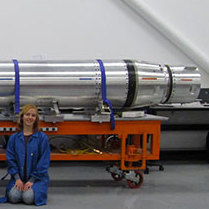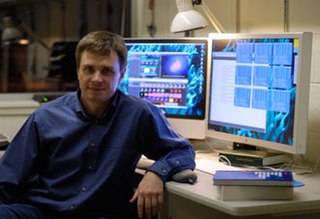The Bruno Rossi Prize is awarded annually by the High Energy Astrophysics division of the American Astronomical Society "for a significant contribution to High Energy Astrophysics, with particular emphasis on recent, original work". Named after astrophysicist Bruno Rossi, the prize is awarded with a certificate and a gift of USD $500, and was first awarded in 1985 to William R. Forman and Christine Jones Forman "for pioneering work in the study of X-ray emission from early type galaxies". It has been awarded 32 times. In 2010, the prize was awarded to William B. Atwood, Peter Michelson and the Fermi Gamma-ray Space Telescope team "for enabling, through the development of the Large Area Telescope, new insights into neutron stars, supernova remnants, cosmic rays, binary systems, active galactic nuclei, and gamma-ray bursts". In 2013, the prize was awarded to Roger W. Romani of Leland Stanford Junior University and Alice Harding of Goddard Space Flight Center for their work in developing the theoretical framework underpinning the many exciting pulsar results from Fermi Gamma-ray Space Telescope.
Solar physics is the branch of astrophysics that specializes in the study of the Sun. It deals with detailed measurements that are possible only for our closest star. It intersects with many disciplines of pure physics, astrophysics, and computer science, including fluid dynamics, plasma physics including magnetohydrodynamics, seismology, particle physics, atomic physics, nuclear physics, stellar evolution, space physics, spectroscopy, radiative transfer, applied optics, signal processing, computer vision, computational physics, stellar physics and solar astronomy.

Dr. Kimberly A. Weaver is an American astrophysics astronomer and professor. She has worked with NASA on several research projects. She is often seen on television programs about astronomy. She is an expert in the area of x-ray astronomy.

The Gravity and Extreme Magnetism SMEX (GEMS) mission was a cancelled space observatory mission. The main scientific goal of GEMS was to be the first mission to systematically measure the polarization of cosmic X-Ray sources. GEMS would have provided data to help scientists study the shape of spacetime that has been distorted by a spinning black hole's gravity and the structure and effects of the magnetic fields around neutron stars. It was cancelled by NASA in June 2012 for potential cost overruns due to delays in developing the technology.

The Interface Region Imaging Spectrograph (IRIS), also called Explorer 94, is a NASA solar observation satellite. The mission was funded through the Small Explorer program to investigate the physical conditions of the solar limb, particularly the chromosphere of the Sun. The spacecraft consists of a satellite bus and spectrometer built by the Lockheed Martin Solar and Astrophysics Laboratory (LMSAL), and a telescope provided by the Smithsonian Astrophysical Observatory. IRIS is operated by LMSAL and NASA's Ames Research Center.

Wendy Laurel Freedman is a Canadian-American astronomer, best known for her measurement of the Hubble constant, and as director of the Carnegie Observatories in Pasadena, California, and Las Campanas, Chile. She is now the John & Marion Sullivan University Professor of Astronomy and Astrophysics at The University of Chicago. Her principal research interests are in observational cosmology, focusing on measuring both the current and past expansion rates of the universe, and on characterizing the nature of dark energy.

Beth A. Brown was a NASA astrophysicist with a research focus on X-ray observations of elliptical galaxies and black holes. She earned a Ph.D. in Astronomy from the University of Michigan in 1998, becoming the first African-American woman to do so.

Fiona A. Harrison is the Kent and Joyce Kresa Leadership Chair of the Division of Physics, Mathematics and Astronomy at Caltech, Harold A. Rosen Professor of Physics at Caltech and the Principal Investigator for NASA's Nuclear Spectroscopic Telescope Array (NuSTAR) mission. She won the Hans Bethe Prize in 2020 for her work on NuSTAR.

Joan T. Schmelz is the Associate Director for Science and Public Outreach at the Stratospheric Observatory for Infrared Astronomy (SOFIA) for the Universities Space Research Association (USRA). Previously, Schmelz was the Deputy Director of Arecibo Observatory and the Director of USRA Operations at Arecibo from 2015 through 2018. Before joining USRA, Schmelz was an NSF Program Director in the Astronomical Sciences Division, where she oversaw the Astronomy & Astrophysics Postdoctoral Fellowship program, and a professor of physics at the University of Memphis from 1996 to 2017. Schmelz's research focus is heliophysics, specifically investigating the coronal heating problem as well as the properties and dynamics of the solar atmosphere. She uses spectroscopic and image data in the X-ray and ultraviolet wavelength ranges obtained from NASA satellites and rockets. She has published over 80 refereed scientific journal articles and authored three books.

Dr. Martin C. Weisskopf is project scientist for NASA's Chandra X-ray Observatory and Chief Scientist for X-ray Astronomy in the Space Sciences Department at NASA's Marshall Space Flight Center in Huntsville, Alabama.

Chryssa Kouveliotou is a Greek astrophysicist. She is a professor at George Washington University and a retired senior technologist in high-energy astrophysics at NASA's Marshall Space Flight Center in Huntsville, Alabama.
Ann Hornschemeier is an American astronomer specializing in X-ray emission from X-ray binary populations. She is the Chief Scientist for the Physics of the Cosmos program at NASA.

Alice Kust Harding is an American astrophysicist at the NASA Goddard Space Flight Center, Greenbelt, Maryland.

Lindsay Erin Glesener is an assistant professor in the University of Minnesota Institute for Astrophysics. She is a National Science Foundation CAREER Award researcher and lead investigator on the FOXSI Sounding Rocket.

Padi Boyd is an American astrophysicist. She is the head of NASA's Exoplanets and Stellar Astrophysics Laboratory and an Associate Director at the Goddard Space Flight Center. She is the project scientist for NASA's Transiting Exoplanet Survey Satellite (TESS) mission.
Therese "Terry" Kucera is an astrophysicist in NASA Goddard Space Flight Center's Solar Physics Laboratory. Her research interests center on the solar atmosphere, especially solar prominences and prominence cavities. She currently serves as Project Scientist for NASA's STEREO project.

Rita M. Sambruna is an Italian-American astrophysicist and is the Deputy Director of the Astrophysics Science Division at National Aeronautics and Space Administration's (NASA) Goddard Space Flight Center. Sambruna held the Clare Boothe Luce Professorship in Physics and Astronomy at George Mason University.

Dr. Alexey Vikhlinin is a Russian-American astrophysicist notable for achievements in the astrophysics of high energy phenomenon, namely galaxy cluster cosmology and the design of space-based X-ray observatories. He is currently a Senior Astrophysicist and Deputy Associate Director of the High Energy Astrophysics Division at the Smithsonian Astrophysical Observatory, part of the Center for Astrophysics | Harvard & Smithsonian in Cambridge, Massachusetts. He is the Science and Technology Definition Team (STDT) Community Co-Chair for the Lynx X-ray Observatory, a NASA-funded Large Mission Concept Study under consideration by the 2020 Decadal Survey on Astronomy and Astrophysics.

Lynnae C. Quick, Ph.D. is an American planetary geophysicist and Ocean Worlds Planetary Scientist at NASA Goddard Space Flight Center. Her research centers on theoretical modeling of cryovolcanic processes on the icy moons and dwarf planets in our solar system as well as modeling volcanic activity on Venus and the Moon. Quick is a member of the Dawn, Europa Clipper, and Dragonfly Mission science teams. She is also a member of the NASA Solar System Exploration Research Virtual Institute (SSERVI) Toolbox for Research and Exploration (TREX) team, and serves as co-chair of the Earth and Planetary Systems Sciences section of the National Society of Black Physicists.
Elizabeth Anne Hays is an American astrophysicist at the NASA Goddard Space Flight Center, where she is chief of the Astroparticle Physics Laboratory and the project scientist for the Fermi Gamma-ray Space Telescope. Her research has included gamma-ray astronomy of the Crab Nebula, novae, and gamma-ray bursts.















